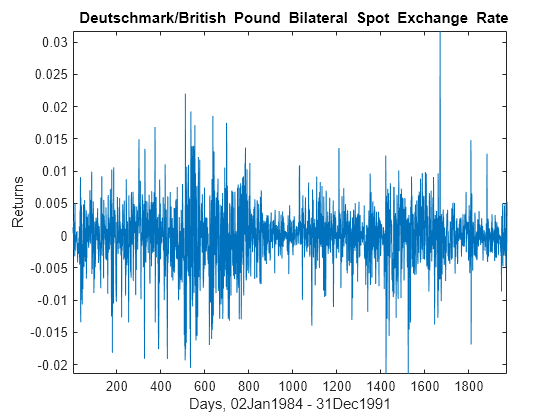waldtest
Wald test of model specification
Syntax
Description
h = waldtest(r,R,EstCov)
If any input argument is a cell vector of length k > 1, then the other input arguments must be cell arrays of length k.
waldtest(r,R,EstCov) treats each cell as a separate, independent test, and returns a vector of rejection decisions.If any input argument is a row vector, then the software returns output arguments as row vectors.
Examples
Input Arguments
Output Arguments
More About
Tips
Estimate unrestricted univariate linear time series models, such as
arimaorgarch, or time series regression models (regARIMA) usingestimate. Estimate unrestricted multivariate linear time series models, such asvarmorvecm, usingestimate.estimatereturns parameter estimates and their covariance estimates, which you can process and use as inputs towaldtest.If you cannot easily compute restricted parameter estimates, then use
waldtest. By comparison:lratiotestrequires both restricted and unrestricted parameter estimates.lmtestrequires restricted parameter estimates.
Algorithms
waldtestperforms multiple, independent tests when the restriction function vector, its Jacobian, and the unrestricted model parameter covariance matrix (r,R, andEstCov, respectively) are equal-length cell vectors.If
EstCovis the same for all tests, butrvaries, thenwaldtest“tests down” against multiple restricted models.If
EstCovvaries among tests, butrdoes not, thenwaldtest“tests up” against multiple unrestricted models.Otherwise,
waldtestcompares model specifications pair-wise.
alphais nominal in that it specifies a rejection probability in the asymptotic distribution. The actual rejection probability is generally greater than the nominal significance.The Wald test rejection error is generally greater than the likelihood ratio and Lagrange multiplier test rejection errors.
References
[1] Davidson, R. and J. G. MacKinnon. Econometric Theory and Methods. Oxford, UK: Oxford University Press, 2004.
[2] Godfrey, L. G. Misspecification Tests in Econometrics. Cambridge, UK: Cambridge University Press, 1997.
[3] Greene, W. H. Econometric Analysis. 6th ed. Upper Saddle River, NJ: Pearson Prentice Hall, 2008.
[4] Hamilton, J. D. Time Series Analysis. Princeton, NJ: Princeton University Press, 1994.
Version History
Introduced in R2009a

